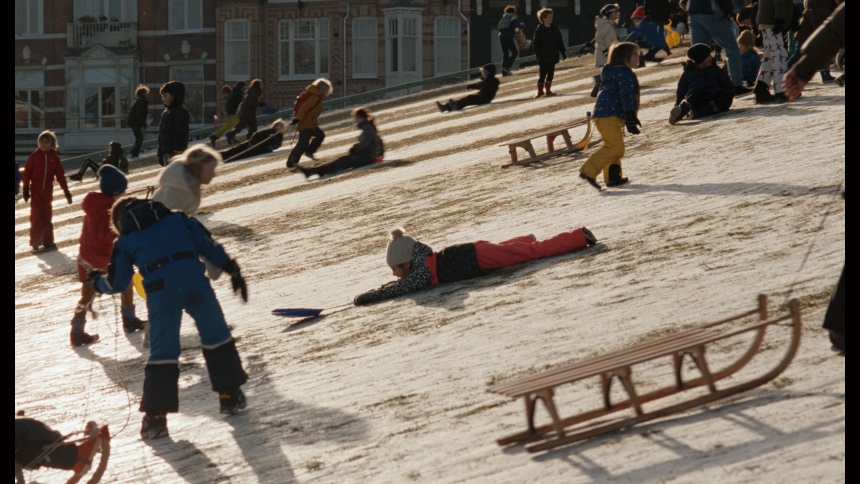Cannes 2023 Review: OCCUPIED CITY, Tales From WWII-Era Amsterdam
Steve McQueen directs a 4.5 hour Holocaust documentary.

Renowned science communicator Carl Sagan said, “extraordinary claims require extraordinary evidence”. This adage can easily be adapted to cinema to state that extraordinary film length requires extraordinary justification. British filmmaker Steve McQueen’s new Holocaust documentary vastly overstays its welcome at four hours and 22 minutes and in the end leaves you numb and exhausted rather than edified or enlightened.
There is precedent for super-long Holocaust documentaries; Claude Lanzmann’s monumental Shoah, after all, unspools over nine and a half hours. But it is the format of Occupied City that makes it so tiring. Documentaries typically employ one or more of several techniques: talking head interviews, archival footage, re-enactments, still images or graphics, animations, voiceover, or newly shot footage. McQueen uses only the last two techniques, to constraining effect.
Occupied City is based on a book by McQueen’s wife, Bianca Stigter, titled Atlas of an Occupied City (Amsterdam 1940-1945). It thus primarily concerns anecdotes about Dutch Jewish victims of Nazi atrocities during the German occupation of the Netherlands and Amsterdam and the efforts of the Resistance fighters to thwart the Nazis, as best as they could. This should all be engrossing and fascinating but McQueen’s delivery drains the premise of its vitality.
During the opening minutes of Occupied City, we hear narrator Melanie Hyams, in crisp English, mention a few Amsterdam addresses (the Dutch names pronounced perfectly) -- Street Number and Street Name -- rattle off the names of some people who lived there and a quick one to two-sentence summary of what happened to them during World War II. We hear this over modern-day B-roll footage of Amsterdam.
You think, this makes for an interesting contrast, seeing some places as they exist today, and hearing about something that happened there 80 years ago. Only, we then hear and see this over and over again, with no breaks or change-ups for four and a half hours. That’s it; that’s the entirety of the movie. There is no other gear to the film. It is four and ½ hours of B-roll of modern-day Amsterdam and a constant, unceasing voiceover throwing names, addresses, and anecdotes at you full blast.
The juxtaposition can often be numbing and distracting. It is as if two entirely different means of expression have been unsuccessfully combined. You almost wonder if the viceover wouldn’t be more successful or impactful with archival footage and pictures and graphics on screen. Or if the B-roll footage of modern-day Amsterdam might not be more fascinating with an overall expansive recounting of the city’s cultural, social, and economic history. But blended together, both seem to lose something in the bargain.
One feels most of all for the hundreds upon hundreds of Jewish victims who are mentioned in passing in Hyams’s fusillade of information. They remain anonymous and faceless, a perverse choice given the history of what happened to them.
There is no attempt to structure or break up the film in any way. There are no chapter breaks or geographical organization or map to guide viewers. The film jumps willy-nilly from address to address to address in Amsterdam and there is no sense of any thought being put into how these anecdotes were organized.
There isn’t even any chronology, as we hear one anecdote from 1943, then 1940, then 1944, and then back again, and back and forth, all over the timeline. The entire film seems arbitrary in that regard, like you could scramble its edit in the Adobe Premiere or Apple Final Cut Pro or whatever was used to assemble the film, and the film wouldn’t turn out appreciably different in experience, only in specifics.
The B-roll of Amsterdam is also all over the place. We see familiar Amsterdam landmarks, scenes of bustling crowds and COVID lockdowns, parties, and domestic scenes, dance training and sports, museums and parks, red-light districts and churches, and even, for some reason, two young women peeing in public. There is some randomly selected, vertiginous drone footage thrown in too at the hour mark.
The film isn’t entirely a hack job. The B-roll footage, shot with modern HD cameras, is sharp, bright, and framed with a filmmaker's eye. The voiceover is clear and mixed well with any music or ambient sound. The research is undoubtedly thorough and admirable and despite the presentation, the anecdotes do interest you as this is a side of Amsterdam most viewers would be unfamiliar with.
Still, by the time the 400th street address is mentioned, and the thousandth person named, and the umpteenth atrocity or act of daring recounted, you have lost the gumption to interact with the information in any meaningful way and Occupied City becomes an ordeal to be endured rather than a cathartic epiphany.
Occupied City was apparently conceived first and foremost as an art installation for museums. It’s impossible to walk away from it without thinking that is where it belongs and that is where it should stay.
Occupied City premiered at the 2023 Cannes Film Festival and will be relased domestically by A24 Films.
Occupied City
Director(s)
- Steve McQueen
Writer(s)
- Bianca Stigter
Cast
- Melanie Hyams

Do you feel this content is inappropriate or infringes upon your rights? Click here to report it, or see our DMCA policy.






